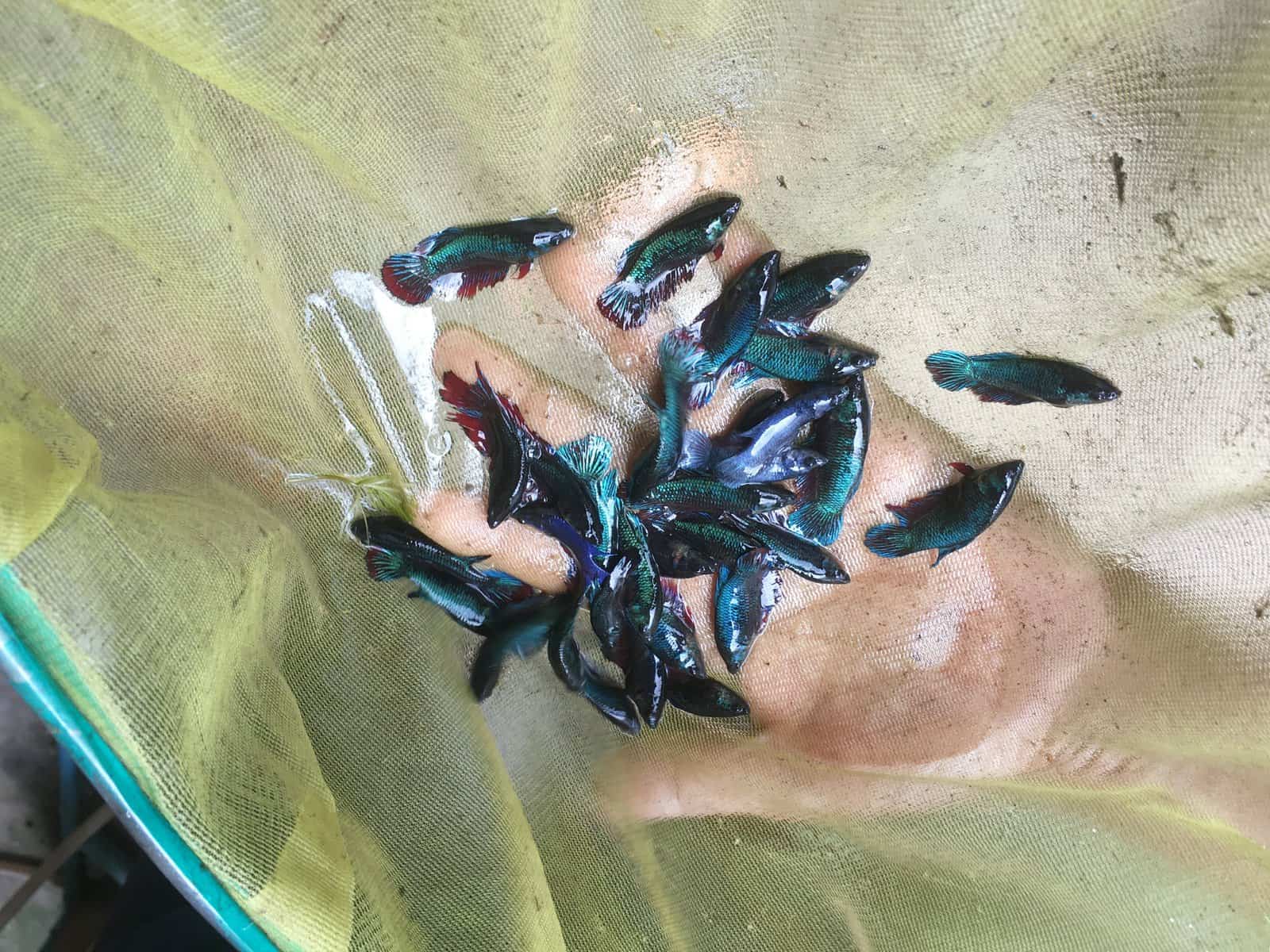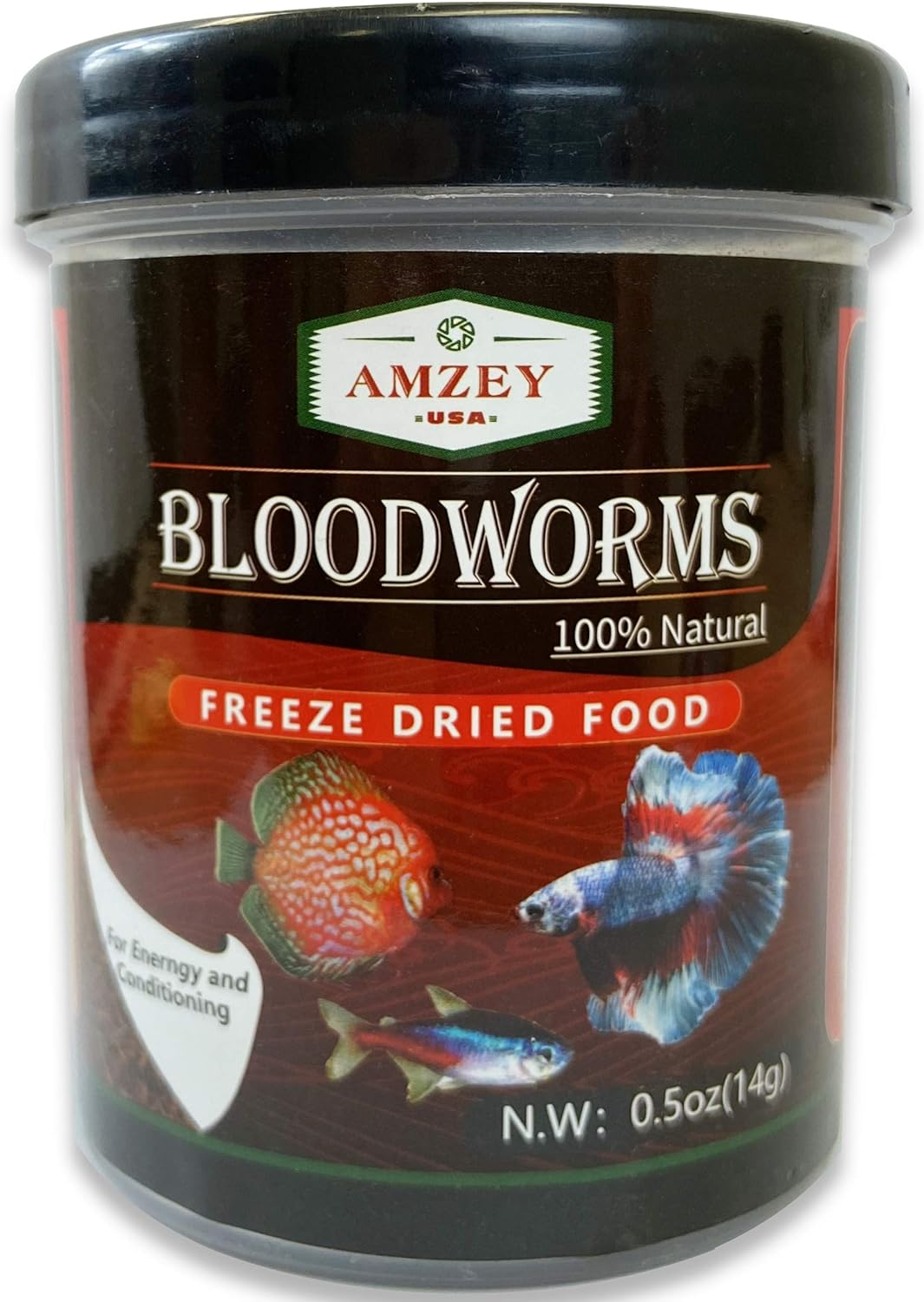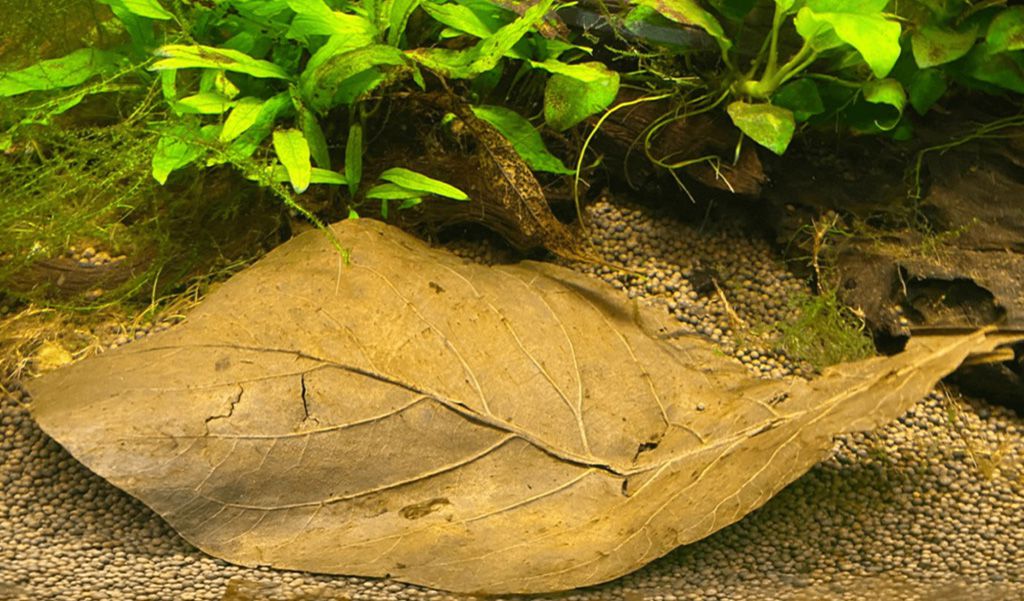Matt
Betta Fish Types & Species For Your Aquarium
If you think bettas are just vibrant fighters in bowls, think again! The world of wild betta fish is a realm teeming with diversity and surprising behaviors. With a staggering 73 known species, these stunning fish are far more than their domesticated cousins.
Wild bettas offer captivating alternatives to the ubiquitous Siamese fighting fish. From tiny bubble-nesters to larger, fascinating mouthbrooders, each species boasts unique adaptations and personalities.
Types of Betta Fish
Here’s a
Betta Fish Are Not Easy To Care For! Click Here For What You Need to Know…
Here’s a glimpse into the diverse world of wild betta species:
- Betta Splendens (Siamese Fighting Fish): The iconic ancestor of domestic bettas, this species is known for its bold coloration and somewhat aggressive nature.
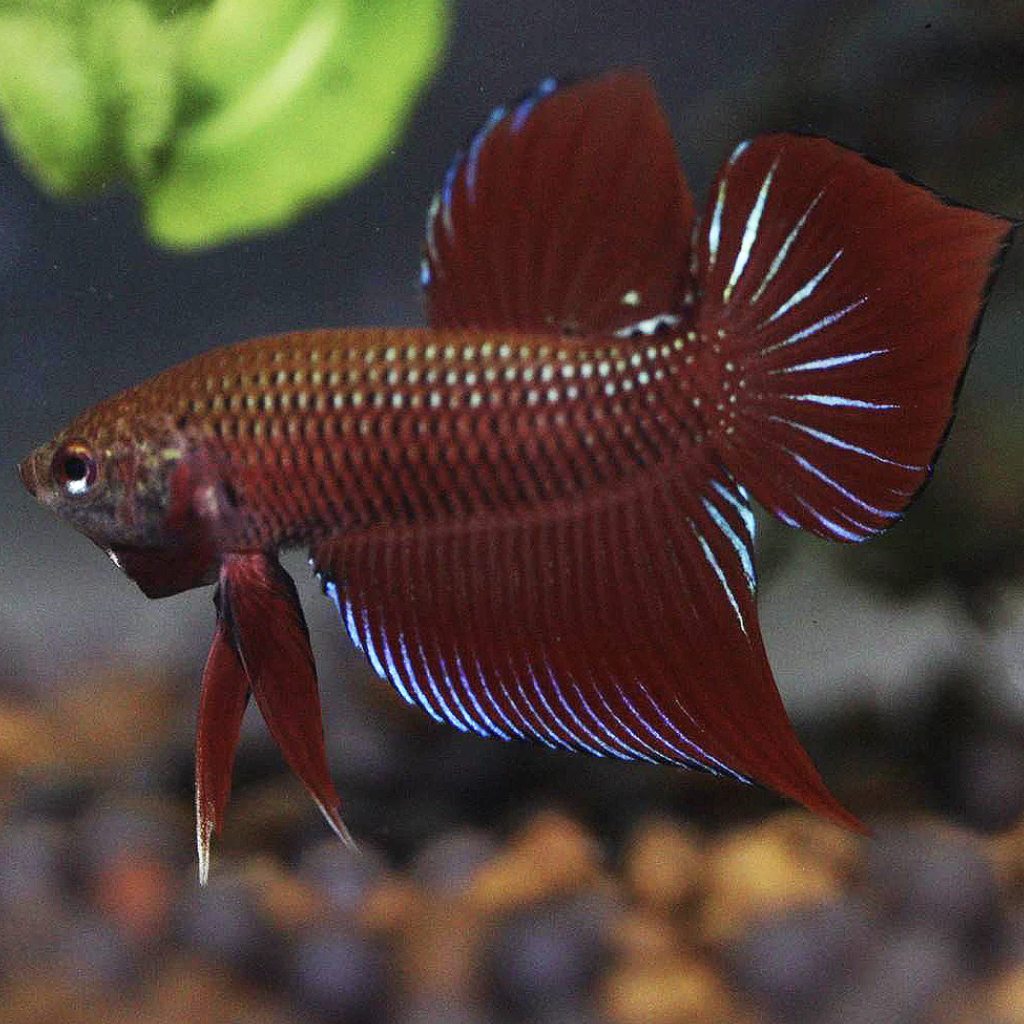
- Betta Imbellis (Peaceful Betta): This Malaysian beauty sports a shimmering green body with a striking red marking on its tail fin. They truly live up to their ‘peaceful’ name.
![]()
- Betta Smaragdina (Emerald Betta): This Thai stunner shimmers with iridescent green-blue scales and bursts of red in its fins. They’re one of the hardiest wild bettas, great for beginners!
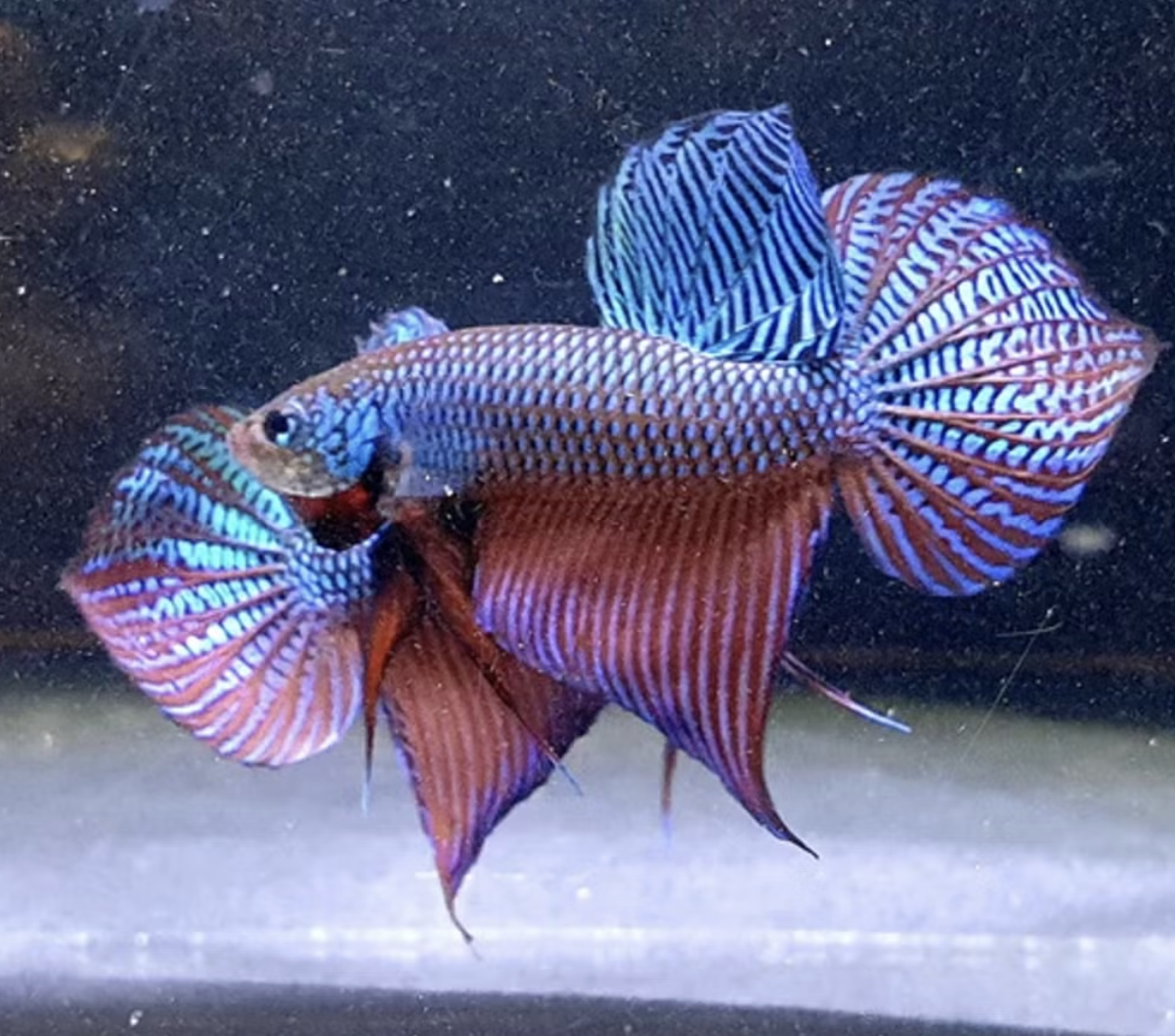
- Betta Mahachaiensis (Mahachai Betta): Another Thai native, this betta sports metallic green scales, red fins, and a unique ‘mask’ of black across the face. They are close cousins of Betta splendens.

- Betta Macrostoma (Brunei Beauty): This large and powerful betta is a paternal mouthbrooder prized for its distinct markings. Males can change patterns in a flash, becoming remarkably colorful under certain conditions.
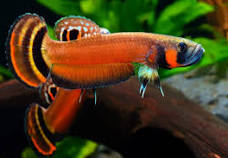
- Betta Coccina (Scarlet Betta): Bold red fins and a deep crimson body mark this fiery fish. They are mouthbrooders found in Indonesian peat swamps, where the water is soft and acidic.

- Betta Foerschi: A Bornean mouthbrooder that thrives in acidic waters and shares some coloration with Betta hendra.
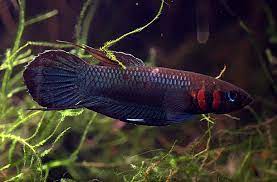
- Betta Rubra: This Sumatran wonder wows with its deep red hue. Males are fiercely devoted parents, protecting eggs and fry.
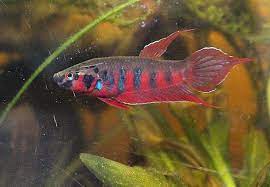
- Betta Channoides (Snakehead Betta): Instantly recognizable by its bright orange-red tones and surprisingly peaceful disposition. It’s perfect for those interested in a community of wild bettas.
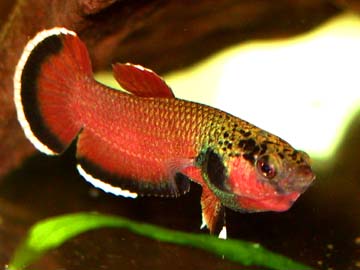
Stiktos Group
- Betta Stiktos: A tiny betta with a big personality. They sport a black body with a scattering of iridescent blue spots. Despite their size, males can be feisty and are known for their beautiful bubble nests.

Siamorientalis Group
- Betta Siamorientalis: This species features a striking blue body with a contrasting red splash on the gill cover. Known as the blue betta, it is also known for being relatively peaceful, they can sometimes be kept in community settings.

Commonly Found
-
Betta Pallifina: A mesmerizing betta with an almost translucent body and delicate fins sporting hints of blue and red. They prefer cooler waters than many other wild betta species.

-
Betta Hendra: This species shares some similarities with Betta foerschi, though it tends to have a more subdued coloration. They are mouthbrooders found in the same habitats as Betta foerschi.

-
Betta Uberis: Another mouthbrooding betta with a unique beauty. Their subdued body coloration is accented by vibrant blues and reds in their fins, resembling fireworks.

This list includes scientifically described species and some known by their locality or provisional names. The Betta genus is remarkably diverse, and new species are occasionally described as research progresses.
-
B. splendens complex (Fighting Fish)
• Betta splendens (Siamese fighting fish)
• Betta imbellis (Crescent betta)
• Betta smaragdina (Emerald betta)
• Betta mahachaiensis
• Betta siamorientalis
• Betta stiktosB. coccina complex (Wine Red Bettas)
• Betta coccina
• Betta livida
• Betta rutilans
• Betta tussyae
• Betta persephone
• Betta burdigala
• Betta brownorum
• Betta uberis
• Betta hendra
• Betta miniopinnaB. pugnax complex
• Betta pugnax (Penang betta)
• Betta fusca (Dusky betta)
• Betta prima
• Betta pallida
• Betta pulchra
• Betta schalleri
• Betta stigmosa
• Betta lehi
• Betta cracens
• Betta enisae
• Betta ferox
• Betta apollon
• Betta kuehnei
• Betta raja
• Betta breviobesaB. unimaculata complex
• Betta unimaculata
• Betta macrostoma (Spotfin betta)
• Betta patoti
• Betta ocellata
• Betta gladiator
• Betta ideii
• Betta compunctaB. albimarginata complex
• Betta albimarginata
• Betta channoidesB. akarensis complex
• Betta akarensis (Akar betta)
• Betta balunga
• Betta chini
• Betta ibanorum
• Betta obscura
• Betta pinguis
• Betta antoni
• Betta aurigans
• Betta nuluhonB. anabatoides complex
• Betta anabatoides (Giant betta)
• Betta midasB. bellica complex
• Betta bellica (Slim betta)
• Betta simorumOther notable species
• Betta foerschi
• Betta rubra
• Betta dimidiata
• Betta edithae
• Betta picta
• Betta taeniata
Types of Betta Fish Tails
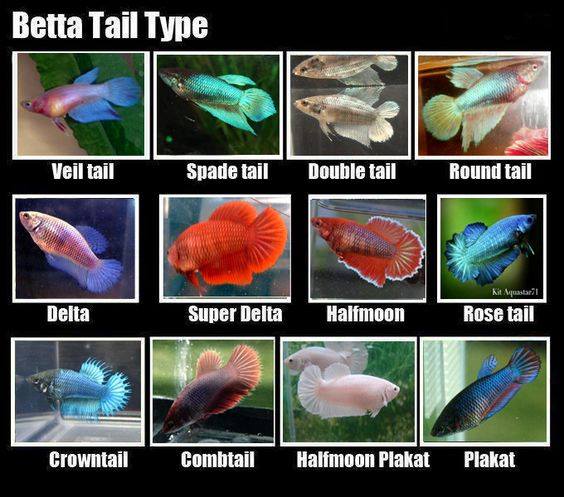
Betta Fish Tail Types
| Tail Type | Description | Care Difficulty | Special Needs |
|---|---|---|---|
| Veil Tail | Long, flowing, and asymmetrical tails | Easy | None |
| Crowntail | Spiky fins due to reduced webbing between the rays | Moderate | Frequent water changes to prevent fin damage |
| Halfmoon | Tails spread to 180 degrees, resembling a half-moon | Moderate | Prone to fin tears, needs gentle water flow |
| Double Tail | Two distinct caudal fins | Difficult | Susceptible to swim bladder disorder |
| Plakat | Shorter, more rounded fins, similar to wild Betta fish | Easy | None |
| Delta Tail | Triangular-shaped tails that widen at the tip | Moderate | Needs larger tank due to fin size |
| Super Delta | Enhanced Delta Tail that approaches a 180-degree spread | Moderate | Same as Delta Tail with additional care for fin health |
| Rosetail | Excessive branching of the fin rays | Difficult | Prone to tail-biting, needs monitoring |
| Feathertail | More extensive ruffles than Rosetail | Difficult | Prone to tail-biting, needs monitoring |
| Spade Tail | Tails shaped like a spade from a deck of cards | Moderate | None |
| Combtail | Mix between Crowntail and other types, with webbing extending more than Crowntails but less than traditional fins | Moderate | None |
| Round Tail | Rounded fins without the taper seen in Deltas | Easy | None |
| Elephant Ear (Dumbo) | Large pectoral fins resembling elephant ears | Moderate | Gentle water flow due to large pectoral fins |
| Over-Halfmoon | Tails extend beyond 180 degrees | Difficult | Similar to Halfmoon, with additional fin care |
| Half-Sun | Mix between Halfmoon and Crowntail, with rays extending beyond the caudal fin’s membrane | Difficult | Similar to Halfmoon, with additional fin care |
Embarking on Your Wild Betta Adventure: A Guide
Ready to bring the vibrancy of wild bettas into your aquarium? Click here for our article on betta fish care.
Consider these factors:
- Beginner’s Bettas: If you’re new to wild bettas, opt for species from the Betta splendens complex, like Betta imbellis, as they tend to be more forgiving.
- Mouthbrooder Marvels: For a taste of this unique behavior, the manageable size and potential for group living make Betta channoides a good starter.
- Advanced Beauty: Betta macrostoma (Brunei Beauty) rewards experienced aquarists seeking a challenge with its dazzling appearance.
Caring for a Piece of the Wild
- Know Your Betta: Research is essential! Understand your chosen species’ specific water needs, ideal tank setup, and dietary preferences.
- Nature’s Touch: To promote your betta’s health, replicate their natural environments, use plants and hiding places, and ensure proper water chemistry.
- Temperament Matters: Some wild bettas, particularly the wild-type Betta splendens, are territorial. Consider solitary setups or compatible tankmates carefully.
The Allure of Wild Bettas
Exploring the world of wild bettas is a journey rich in beauty and responsibility. From the gentle Betta imbellis to the dazzling Betta rubra, enthusiasts of all levels can discover a treasure. By responsibly caring for them, you gain a dazzling aquarium centerpiece while supporting the understanding and conservation of these fascinating fish.
How To Take Care of a Betta Fish
Betta fish are resilient, but proper care is essential to ensure they live up to their potential lifespan of 3-5 years, and sometimes even longer. In this guide, you’ll learn everything you need to know to provide the best care for your betta fish and create a healthy, stress-free environment.
Betta Care: Healthy vs. Sick Checklist
Recognizing signs of health and illness early on is key to preventing more serious problems. Below are the characteristics of both healthy and sick betta fish:
- Healthy Betta Characteristics:
- Bright, vibrant colors
- Active and curious behavior
- Smooth, undamaged fins
- Clear eyes and a regular appetite
- Regular swimming and exploration
- Frequent visits to the water’s surface for air
- Sick Betta Characteristics:
- Dull or faded colors
- Lethargy or excessive hiding
- Clamped or tattered fins
- Loss of appetite, bloating, or weight loss
- White spots, black edges on fins (possible signs of fin rot), or visible swelling
- Abnormal swimming patterns or labored breathing
Water Conditions: pH, Ammonia, and Water Chemistry
Maintaining the correct water parameters is crucial for your betta’s well-being. Poor water quality is a leading cause of stress and illness in betta fish.
- pH Levels:
- Bettas thrive in water with a pH range of 6.5 to 7.5.
- To lower pH, you can add driftwood, Indian almond leaves, or a pH-lowering solution.
- To raise pH, use crushed coral, limestone, or pH-raising products.
- Regularly monitor pH levels using a pH test kit to prevent sudden fluctuations, which can cause stress.
- Ammonia, Nitrite, and Nitrate Levels:
- Ammonia: Should always be 0 ppm. Even trace amounts of ammonia can cause severe stress and burns to a betta’s gills.
- Nitrite: Should also be 0 ppm. Nitrite toxicity causes oxygen deprivation, leading to stress and eventual death.
- Nitrate: Should be kept below 20 ppm. Nitrates are less toxic but can contribute to poor water quality and algae growth.
- Water Hardness:
- General Hardness (GH): Soft to slightly hard water (50-150 ppm) is preferred for bettas.
- Carbonate Hardness (KH): A 3-5 dKH range helps buffer and stabilize the pH, reducing harmful fluctuations.
- Filtration and Water Treatment:
- Use a low-flow filter to prevent damaging your betta’s delicate fins.
- Treat water with Seachem Prime or another water conditioner to neutralize chlorine, chloramine, and heavy metals from tap water.
- Keep a testing kit on hand to regularly check water parameters.
- Tank Size and Environment
Creating the ideal environment is vital to your betta’s overall health and happiness.
- Tank Size: The minimum recommended fish tank size for a betta is 5 gallons. Larger tanks are more stable and easier to maintain and provide a betta with ample room to swim and explore.
- Lighting and Temperature:
- Use a gentle aquarium light with a regular 8-12 hour light cycle. Do not place the tank in direct sunlight, as this can lead to dangerous temperature fluctuations.
- Maintain water temperature between 76-81°F (24-27°C). A heater with an adjustable thermostat is necessary, especially in cooler climates.
- Tank Mates: While bettas are territorial and aggressive, they can cohabitate with certain peaceful species such as snails, Corydoras, or small, non-aggressive fish like neon tetras. Be cautious and monitor interactions closely.
- Plants, Hideouts, and Decorations
Bettas enjoy a well-decorated tank that mimics their natural environment.
- Live Plants: Plants like Java Moss, Anubias, and Amazon Swords offer both beauty and functionality by absorbing nitrates and providing hiding spots.
- Hideouts: Bettas like to feel safe, so provide smooth caves, silk plants, and hideaways. Avoid sharp objects that could damage their fins.
- Decoration Placement: Ensure there’s plenty of open space for swimming while still offering sheltered areas for resting.
- Water Maintenance and Cleaning
Maintaining water quality is key to preventing illness and ensuring a healthy environment.
- Water Changes:
- Perform weekly water changes of 25% to keep water parameters stable and reduce toxins.
- In smaller, unfiltered tanks, more frequent changes may be needed.
- Cleaning the Tank:
- Gravel vacuums are great for cleaning the substrate and remove excess food and waste.
- Rinse decorations in used tank water (never use soap) to prevent algae buildup.
- Betta Diet and Feeding Guidelines
A varied diet is critical to your betta’s health and vibrant colors.
- Dietary Needs:
- Bettas are carnivores and do best on a protein-rich diet.
- Staple foods include high-quality betta pellets made from fish or shrimp meal.
- Treats and Supplements: Offer live, frozen, or freeze-dried foods like bloodworms, daphnia, and brine shrimp as occasional treats (2-3 times a week).
- Feeding Schedule:
- Feed 2-3 pellets twice a day, ensuring you only offer what they can eat in 2-3 minutes.
- Avoid overfeeding to prevent bloating and poor water quality.
- Fasting Day:
- Fast your betta for one day per week to help with digestion and to help reduce the risk of bloating.
- Betta Health Tips and Troubleshooting
Here are some common problems and tips for resolving them.
- Fin Rot:
- Symptoms: Fins appear ragged, torn, or have black/brown edges.
- Causes: Poor water quality, injury, or stress.
- Treatment: Improve water conditions, add aquarium salt, and use fin rot medications like API Fin & Body Cure.
- Swim Bladder Disorder:
- Symptoms: Difficulty swimming, floating upside down, or sinking.
- Causes: Overfeeding or constipation.
- Treatment: Fast your betta for 24-48 hours, then offer a blanched pea or high-fiber food.
- Ich (White Spot Disease):
- Symptoms: Small white spots and dots on the body and fins, scratching against surfaces.
- Causes: Parasite infection.
- Treatment: Increase tank temperature to 82°F gradually, treat with anti-parasitic medication.
- Ammonia Poisoning:
- Symptoms: Red gills, gasping for air at the surface, lethargy.
- Causes: High ammonia levels in the tank.
- Treatment: Immediate water changes and use of a detoxifying conditioner like Seachem Prime.
- Constipation/Bloating:
- Symptoms: Swollen belly, reduced appetite.
- Causes: Overfeeding or poor diet.
- Treatment: Fast for a day or two and offer a blanched pea or daphnia to aid digestion.
Wild Betta Fish 101: Care, Tank, Breeding & More
Did you know that the dazzling betta fish you see in pet stores started their journey in the muddy rice paddies of Southeast Asia? These vibrant fish, known for their flowing fins and feisty attitudes, have a wild ancestor that is quite different from the familiar pet. Let’s explore the world of wild betta fish, learn how they thrive in their complex natural environments, and consider the importance of their conservation.
Sadly, many wild betta populations are dwindling. Habitat loss and over-collection threaten these beautiful creatures. This guide goes into the fascinating lives of wild bettas, providing tips for responsible care and highlighting the importance of conservation — however if you’re looking for an in-depth article please check out our master guide here.
Wild Betta Species
Betta fish aren’t a single uniform species! There’s a surprising amount of diversity within the Betta genus, with over 70 known types. Let’s look at a few of the most popular wild betta species kept by aquarists:
- Betta splendens (Siamese Fighting Fish): This is the most familiar wild betta, the ancestor of our brightly colored pet store companions. In their native Southeast Asian habitats, they inhabit shallow ponds, marshes, and rice paddies. Even in the wild, their care needs resemble their domesticated counterparts.

Photo credit: Franks bettas
- Betta imbellis (Peaceful Betta): These bettas are smaller and less aggressive than Betta splendens. Their natural habitat is similar, and they are good candidates for community tanks with other peaceful, small fish.

Photos from Franks Bettas
- Betta smaragdina (Emerald Betta): This betta glows with iridescent green and blue scales. They require a heavily planted environment with soft, acidic water to reach their full potential.

Photo credit: Fishy hub
Bubble Nesting vs. Mouthbrooding Betta Fish
Betta fish have two fascinating ways of caring for their young: bubble nesting and mouthbrooding.
- Bubble Nesters: Like Betta splendens, male bubble nesters create intricate floating nests from saliva bubbles. Eggs are deposited in the nest, and the male fiercely guards them.
- Mouthbrooders: Some betta species, like Betta imbellis, are mouthbrooders. The male or female carries the eggs in their mouth until they hatch, offering incredible protection.
These breeding behaviors affect how you care for wild bettas. Bubble nesters need a calm water surface, while mouthbrooders may need specialized environments to encourage spawning. Understanding how wild betta fish reproduce offers insights into their unique needs in captivity. We have a great article on betta fish eggs here.
Wild Betta Tank Setup
Replicating a wild betta’s natural habitat is crucial for their well-being. Here’s what you need to know:
- Tank Environment: Wild bettas typically inhabit shallow, slow-moving waters. Opt for smaller tanks (5-10 gallons for most species), densely planted with aquatic vegetation. Indian almond leaves offer beneficial tannins and mimic their native environment.
- Filtration Systems: Gentle filters, like sponge filters, are best. Wild bettas aren’t used to strong currents. You can also clean the tank using a suction vacuum.
Wild Betta Fish Care
- Comprehensive Care: Feed your wild bettas a varied diet of high-quality live or frozen foods like bloodworms, brine shrimp, and daphnia. Maintain pristine water conditions, and carefully select tankmates if you plan on a community aquarium (small, peaceful fish only). Breeding wild bettas can be rewarding, but research your specific species’ needs.
- Dealing with Diseases: The best disease prevention is a clean tank with optimal water parameters. Research common ailments in wild bettas and prioritize reducing stress in your aquarium.
Where to Buy Wild Betta Fish
- Ethical Purchasing: Choose breeders that prioritize conservation and ethical breeding practices. Look for certifications or a reputation for responsible sourcing.
Conclusion
Wild betta fish are incredible creatures with intricate behaviors and fascinating adaptations. By understanding their needs and respecting their delicate habitats, we can enjoy these captivating fish responsibly and help conserve them for future generations. Let’s all do our part to protect these remarkable jewels of Southeast Asia!
Where Do Betta Fish Live In The Wild
Bettas are natively found in:
Rice paddies: Shallow, warm waters ideal for bettas, providing abundant food and serving as mosquito control.
Peat swamps: Acidic, nutrient-rich waters with dense vegetation, offering a sanctuary for many betta species.
Slow-moving streams and ponds: Calm waters with aquatic plants, providing hiding spots and ambush opportunities.
Blackwater streams: Dark, tannin-rich waters formed by decomposed organic matter, home to specialized betta species.
Table of Species and Where They’re Found in the Wild
| Complex | Species | Common Name | Natural Habitat | Native Countries/Regions |
|---|---|---|---|---|
| Betta akarensis Complex | Betta akarensis | Akar Betta | Blackwater streams, peat swamps | Malaysia (Sarawak, Borneo) |
| Betta akarensis Complex | Betta antoni | Peat swamps, forest streams | Indonesia (Sumatra) | |
| Betta akarensis Complex | Betta aurigans | Blackwater streams | Indonesia (Kalimantan, Borneo) | |
| Betta akarensis Complex | Betta balunga | Forest streams | Malaysia (Sabah, Borneo) | |
| Betta akarensis Complex | Betta chini | Peat swamps | Malaysia (Sabah, Borneo) | |
| Betta akarensis Complex | Betta ibanorum | Peat swamps, blackwater streams | Malaysia (Sarawak, Borneo) | |
| Betta akarensis Complex | Betta nuluhon | Forest streams | Malaysia (Sabah, Borneo) | |
| Betta akarensis Complex | Betta obscura | Peat swamps, slow-moving streams | Indonesia (Kalimantan, Borneo) | |
| Betta akarensis Complex | Betta pinguis | Peat swamps | Indonesia (Kalimantan, Borneo) | |
| Betta albimarginata Complex | Betta albimarginata | Forest streams with leaf litter | Indonesia (Borneo) | |
| Betta albimarginata Complex | Betta channoides | Peat swamps, blackwater streams | Indonesia (East Kalimantan, Borneo) | |
| Betta anabatoides Complex | Betta anabatoides | Giant Betta | Peat swamps, blackwater habitats | Indonesia (Borneo) |
| Betta anabatoides Complex | Betta midas | Peat swamps | Indonesia (Borneo) | |
| Betta bellica Complex | Betta bellica | Slim Betta | Slow-moving waters, swamps, ponds | Malaysia, Thailand |
| Betta bellica Complex | Betta simorum | Peat swamps | Indonesia (Sumatra) | |
| Betta coccina Complex | Betta brownorum | Peat swamps, blackwater streams | Malaysia (Sarawak, Borneo) | |
| Betta coccina Complex | Betta burdigala | Peat swamps | Indonesia (Sumatra) | |
| Betta coccina Complex | Betta coccina | Peat swamps, forest streams | Indonesia (Sumatra) | |
| Betta coccina Complex | Betta hendra | Peat swamps | Indonesia (Kalimantan, Borneo) | |
| Betta coccina Complex | Betta livida | Peat swamps | Malaysia (Peninsular) | |
| Betta coccina Complex | Betta miniopinna | Peat swamps | Indonesia (Sumatra) | |
| Betta coccina Complex | Betta persephone | Peat swamps, blackwater streams | Malaysia (Peninsular) | |
| Betta coccina Complex | Betta rutilans | Peat swamps | Indonesia (Kalimantan, Borneo) | |
| Betta coccina Complex | Betta tussyae | Peat swamps | Malaysia (Peninsular) | |
| Betta coccina Complex | Betta uberis | Peat swamps | Indonesia (Sumatra) | |
| Betta dimidiata Complex | Betta dimidiata | Peat swamps, blackwater streams | Malaysia (Sarawak, Borneo) | |
| Betta dimidiata Complex | Betta krataios | Peat swamps | Indonesia (Borneo) | |
| Betta edithae Complex | Betta edithae | Peat swamps | Indonesia (Sumatra) | |
| Betta foerschi Complex | Betta dennisyongi | Peat swamps | Indonesia (Borneo) | |
| Betta foerschi Complex | Betta foerschi | Peat swamps, blackwater streams | Indonesia (Kalimantan, Borneo) | |
| Betta foerschi Complex | Betta mandor | Peat swamps | Indonesia (Borneo) | |
| Betta foerschi Complex | Betta rubra | Peat swamps, forest streams | Indonesia (Sumatra) | |
| Betta foerschi Complex | Betta strohi | Peat swamps | Indonesia (Borneo) | |
| Betta picta Complex | Betta falx | Peat swamps | Indonesia (Sumatra) | |
| Betta picta Complex | Betta picta | Spotted Betta | Streams, rivers | Indonesia (Sumatra, Java) |
| Betta picta Complex | Betta simplex | Streams, ponds | Thailand (Krabi) | |
| Betta picta Complex | Betta taeniata | Peat swamps | Malaysia (Sarawak, Borneo) | |
| Betta pugnax Complex | Betta apollon | Forest streams | Malaysia (Peninsular) | |
| Betta pugnax Complex | Betta breviobesus | Peat swamps | Indonesia (Sumatra) | |
| Betta pugnax Complex | Betta cracens | Peat swamps | Indonesia (Borneo) | |
| Betta pugnax Complex | Betta enisae | Peat swamps | Indonesia (Borneo) | |
| Betta pugnax Complex | Betta ferox | Peat swamps | Indonesia (Borneo) | |
| Betta pugnax Complex | Betta fusca | Dusky Betta | Streams, rivers | Malaysia (Peninsular, Borneo) |
| Betta pugnax Complex | Betta kuehnei | Peat swamps | Malaysia (Peninsular) | |
| Betta pugnax Complex | Betta lehi | Peat swamps | Indonesia (Borneo) | |
| Betta pugnax Complex | Betta pallida | Peat swamps | Thailand | |
| Betta pugnax Complex | Betta prima | Peat swamps | Indonesia (Sumatra) | |
| Betta pugnax Complex | Betta pugnax | Penang Betta | Streams, rivers | Malaysia (Peninsular, Sumatra) |
| Betta pugnax Complex | Betta pulchra | Peat swamps | Indonesia (Borneo) | |
| Betta pugnax Complex | Betta raja | Peat swamps | Indonesia (Sumatra) | |
| Betta pugnax Complex | Betta schalleri | Peat swamps | Indonesia (Borneo) | |
| Betta pugnax Complex | Betta stigmosa | Peat swamps | Indonesia (Borneo) | |
| Betta splendens Complex | Betta imbellis | Crescent Betta | Shallow streams, swamps | Thailand, Malaysia |
| Betta splendens Complex | Betta mahachaiensis | Brackish, estuarine | Thailand | |
| Betta splendens Complex | Betta siamorientalis | Shallow wetlands | Thailand | |
| Betta splendens Complex | Betta smaragdina | Blue Betta | Freshwater streams | Indonesia |
| Betta splendens Complex | Betta splendens | Siamese Fighting Fish | Ponds, rice paddies | Thailand, Cambodia, Vietnam |
| Betta splendens Complex | Betta stiktos | Shallow wetlands | Thailand | |
| Betta unimaculata Complex | Betta compuncta | Forest streams | Borneo | |
| Betta unimaculata Complex | Betta gladiator | Forest streams, swamps | Borneo | |
| Betta unimaculata Complex | Betta ideii | Freshwater streams | Borneo | |
| Betta unimaculata Complex | Betta macrostoma | Spotfin Betta | Clear forest streams | Brunei, Malaysia (Borneo) |
| Betta unimaculata Complex | Betta ocellata | Forest streams | Borneo | |
| Betta unimaculata Complex | Betta pallifina | Forest streams | Malaysia (Peninsular) | |
| Betta unimaculata Complex | Betta patoti | Forest streams, swamps | Indonesia (Sumatra) | |
| Betta unimaculata Complex | Betta unimaculata | Howong Betta | Slow-moving streams | Malaysia (Borneo) |
| Betta waseri Complex | Betta andrei | Peat swamps | Indonesia (Borneo) | |
| Betta waseri Complex | Betta chloropharynx | Blackwater streams | Indonesia (Borneo) | |
| Betta waseri Complex | Betta hipposideros | Peat swamps | Indonesia (Borneo) | |
| Betta waseri Complex | Betta omega | Peat swamps | Indonesia (Borneo) | |
| Betta waseri Complex | Betta pardalotos | Forest streams | Indonesia (Borneo) | |
| Betta waseri Complex | Betta pi | Peat swamps | Indonesia (Borneo) | |
| Betta waseri Complex | Betta renata | Peat swamps | Indonesia (Borneo) | |
| Betta waseri Complex | Betta spilotogena | Peat swamps | Indonesia (Borneo) | |
| Betta waseri Complex | Betta tomi | Peat swamps | Indonesia (Borneo) | |
| Betta waseri Complex | Betta waseri | Peat swamps, blackwater streams | Indonesia (Borneo) |
Click Here To Buy Exotic Bettas Online From a Reputable Source
Where Do Betta Fish Come From?
Click here if you’re contemplating getting a betta fish… this is a MUST READ…
Wild Betta Characteristics by Region
Thailand, Laos, and Cambodia
In Thailand, Laos, and Cambodia, bettas from the splendens complex are prevalent. These include Betta splendens, Betta smaragdina, and others, known for their bubble-nesting behavior. These species display a range of behaviors and morphologies suited to the shallow, often oxygen-poor waters of rice paddies and slow-moving streams.
Malaysia
Malaysia is home to Betta imbellis and other less-known species like Betta bellica and Betta pugnax. The habitats here resemble those in Thailand but also include unique ecological conditions that influence the behaviors and physical characteristics of local betta populations.
Borneo
On the island of Borneo, betta species such as Betta macrostoma and Betta albimarginata thrive in distinctly tropical environments, characterized by rainforests and a pH as low as 3-4. These conditions foster a different set of adaptations, particularly in terms of breeding and territorial behavior.
Indonesia
In Indonesia, particularly on the islands of Sumatra and Java, a variety of betta species inhabit highland streams and similar environments. Species like Betta picta and Betta coccina are adapted to these habitats, showcasing the diverse ecological roles bettas play across the archipelago.
Bettas In The Wild – Native Habitats
| Region & Natural Habitat | Some Common Wild Betta Species |
|---|---|
| Thailand | Betta splendens (Siamese fighting fish), Betta smaragdina (Emerald betta), Betta imbellis (Peaceful betta) |
| Cambodia | Betta stiktos, Betta siamorientalis |
| Laos | Betta falx, Betta simplex |
| Vietnam | Betta mahachaiensis, Betta prima |
Looking For Exotic Bettas To Own? Click Here To Buy Gorgeous Bettas Online
Wild Betta Characteristics
The wild relatives of the domestic betta are generally less conspicuous, exhibiting subdued hues that serve as camouflage rather than decoration. Among the Betta genus, the splendens complex is perhaps the most famous, consisting of species like Betta splendens itself and its close relatives, which share similar morphological and behavioral traits. In contrast, species found on the islands of Borneo and Indonesia, such as Betta macrostoma, showcase different adaptations to their unique environments.
Natural Habitat Types Bettas Live In
In the wild, bettas inhabit shallow, warm waters like rice paddies, swamps, and slow-moving streams. These habitats are often low in oxygen, which has led bettas to evolve a labyrinth organ—a specialized part of their respiratory system that allows them to breathe air directly from the surface. This adaptation is crucial for survival in stagnant waters that heat up quickly under the tropical sun, reaching temperatures between 74°F and 85°F.
- Warm, tropical waters: Bettas need the temperature to stay within a comfortable range for their health.
- Shallow depth relates to their ability to gulp air from the surface when needed.
- Dense vegetation: Plants offer hiding places, a source of food, and even places for bettas to build nests.
- Tannins: As leaves and other organic matter decay in the water, they release tannins. These have a slightly brown tint but provide health benefits for bettas.
How Long Do Betta Fish Live
The typical lifespan for a betta fish is about 2-4 years, although they can sometimes live up to 5 years with optimal care. Several factors contribute to how long your betta may live, including the quality of their tank environment, diet, genetics, and stress levels. It’s important to remember that betta fish purchased from pet stores may already be around a year old, so even with the best care, their time with you may be shorter. Proper tank maintenance, a nutritious diet, and a low-stress environment are key to helping your betta fish live a long, healthy life. Click here to learn more.
Wild Betta Behavior
Wild bettas are known for their complex behaviors, especially regarding territory and breeding. Males are fiercely territorial, often engaging in displays of fin spreading and color flaunting to deter rivals and attract mates. The species can be divided into two main reproductive groups: bubble-nesters and mouth-brooders. Bubble-nesters, like Betta splendens, create floating nests of air bubbles to protect their eggs and fry, while mouth-brooders, such as Betta macrostoma, carry their offspring in their mouths to ensure their safety.
Other Inhabitants and Environmental Interactions
Bettas share their natural habitats with various other species, including gouramis, rasboras, and barbs. These co-inhabitants often play a role in the dynamics of betta behavior, influencing everything from territorial disputes to breeding success. The dense vegetation and organic materials found in these waters provide hiding spots and breeding grounds for bettas and contribute to the ecological balance by offering shelter and resources to other species.
- Rice paddies: While man-made, these shallow, flooded fields provide a perfect home for bettas.
- Ponds and swamps: Lush with vegetation and teeming with insect life, these slow-moving waters suit bettas well.
- Slow-moving streams: The gentle flow of water is important, but some areas with low oxygen have led bettas to adapt by breathing air directly from the surface.
Best Environment for a Betta Fish: Replicating Their Natural Habitat
To create the best environment for a betta fish in captivity, it’s essential to understand and replicate the conditions of their natural habitats. Wild bettas originate from tropical regions in Southeast Asia, where they thrive in shallow, warm, and plant-rich waters. These environments provide not only physical comfort but also stimulate natural behaviors, ensuring a healthier and more active betta.
Key Elements of a Betta’s Ideal Environment:
- Warm, Stable Water Temperature
- Natural Range: 74°F to 85°F
- Bettas are tropical fish that require consistently warm water to thrive. A heater is essential for maintaining an optimal temperature in their tank. Sudden temperature fluctuations can stress bettas, weakening their immune system and leading to health issues.
- Shallow Depth with Easy Surface Access
- In the wild, bettas inhabit shallow waters, allowing them to easily reach the surface to breathe air using their labyrinth organ. This unique adaptation lets them survive in low-oxygen environments. In an aquarium, a tank height of 12-18 inches is ideal to mimic this natural behavior.
- Dense Vegetation and Hiding Spaces
- Wild bettas live among aquatic plants that provide shelter and security. Incorporating live plants like java fern, anubias, or Amazon swords in your tank not only gives your betta places to hide but also improves water quality by absorbing nitrates and releasing oxygen.
- Tannins for Water Conditioning
- Many wild bettas live in blackwater environments, where tannins from decomposing leaves tint the water and lower its pH. Adding Indian almond leaves or driftwood to the tank can replicate this effect, promoting a healthy immune system and reducing stress for your betta.
- Calm Waters
- Wild bettas thrive in slow-moving or stagnant water. Avoid strong currents in the tank by using a gentle sponge filter or adjusting the flow rate of your filter. Excessive water movement can exhaust bettas and interfere with their bubble-nesting behavior.
- Subdued Lighting
- Bettas prefer low light conditions similar to their shaded natural habitats. Adding floating plants like duckweed or water lettuce can diffuse light and create a more comfortable environment for your fish.
- Water Parameters
- pH Level: 6.0 to 7.5
- Hardness: 3-8 dGH
- Regular water changes and monitoring of ammonia, nitrite, and nitrate levels are crucial for maintaining water quality and preventing stress or illness.
Reproduction Details
Reproductive strategies among wild bettas are fascinating and varied. Bubble-nesters guard their offspring until they are free-swimming, while mouth-brooders provide a mobile sanctuary for their eggs and fry, showcasing a remarkable commitment to parental care. These behaviors reflect adaptations to environmental pressures and predators, highlighting the complexity of life strategies evolved by bettas over millennia. Learn more about betta fish eggs and bubble nests here.
Conclusion
Understanding the natural conditions and behaviors of wild betta fish provides crucial insights for anyone interested in keeping these fish as pets. Aquarium enthusiasts can ensure a healthier, more vibrant life for their bettas by replicating aspects of their natural habitats and respecting their behavioral needs. Beyond decorative elements, bettas are a link to Southeast Asia’s rich and diverse aquatic life, deserving of both admiration and responsible stewardship.
What do betta fish eat in the wild?

Credit: Betaboxx
What Do Betta Fish Eat In The Wild?
In their natural habitat, betta fish are carnivorous and rely on a diet of:
- Insect Larvae: Bettas eat mosquito larvae and those of other insects are vital to their diet. Bettas often lurk near the surface, ready to snatch up these wriggling meals.
- Small Insects: Adult insects that land or fall into the water are a quick snack! Bettas are excellent at spotting movement and will strike with surprising speed.
- Worms: Bloodworms, blackworms, and other small aquatic worms provide bettas with protein and other essential nutrients.
- Tiny Crustaceans: Bettas eagerly consume water fleas (Daphnia), brine shrimp, and similar creatures. These are especially important food sources for young betta fry.
- Surface Specialists: Bettas have upturned mouths designed for scooping food from the water’s surface, making them ideally suited for their environment.
Best Betta Food – What They Can Eat At Home
In captivity, betta fish need a balanced diet to stay healthy and mimic what they would naturally eat in the wild. Click here to learn more about betta fish food. Common options include:
- Betta Pellets: Specially formulated for bettas, these provide essential nutrients.
- Freeze-dried or Frozen Foods: Bloodworms, brine shrimp, and daphnia are great protein-rich treats.
- Live Foods: Live brine shrimp or mosquito larvae can be offered occasionally to replicate a wild diet.
- Vegetables (Occasional): Soft, boiled vegetables like peas can help with digestion, though they shouldn’t form a large part of the diet.
The Staple: Prepared Betta Foods
Click here for my favorite food to feed bettas
- Betta Pellets: These are the nutritional workhorses for your betta. They’re designed to meet a betta’s dietary needs, packing essential vitamins and protein. Floating pellets are best, allowing easy feeding and less water mess. High-quality brands like Hikari, Ocean Nutrition, NorthFin, and New Life Spectrum are excellent choices.
- High-Quality Betta Pellets: Select pellets designed specifically for bettas. Prioritize those listing fish meal, shrimp meal, or other animal-based proteins as the main ingredients. Smaller pellets (1-3mm) that float best match a betta’s natural feeding behavior.
- Flakes: While betta-specific flakes exist, many bettas find them less appealing than pellets. Flakes also break down faster in the water, causing more pollution. You can certainly try betta flakes, but they shouldn’t be your pet’s exclusive diet.
Tasty Treats: Freeze-Dried, Frozen, and Live Foods
- Freeze-Dried Delights: Supplement with treats of live or frozen bloodworms, brine shrimp, or daphnia. Freeze-dried foods, such as bloodworms, offer a less processed whole-food option that is often free from parasites and bacteria.
- These provide a more stimulating feeding experience, additional nutrients, and will even tempt a finicky betta’s appetite.
- Frozen Favorites: Frozen bloodworms, brine shrimp, and daphnia mimic what bettas would enjoy in their natural habitat and provide a flavor boost.
- The Natural Choice: Live Foods: Live options like baby brine shrimp and shrimp coals are the closest to a betta’s wild diet and offer excellent mental stimulation. However, they can be more challenging to source and might carry disease risks.
How Often to Feed Betta Fish
- Small Portions, Big Impact: Bettas should eat twice a day. They have tiny stomachs. Feed them only what they can eat in about 2 minutes. Overfeeding is extremely harmful and leads to health problems and a polluted tank.
- Cleanliness is Key: Uneaten food fouls the water. Promptly remove it after feeding.
- Fasting is Natural: An occasional fast day (skipping a meal) mimics their wild experience where food isn’t always plentiful and can benefit their health.
- Frequency: Feed adult bettas twice a day with the portions mentioned above. Fry requires multiple small meals throughout the day as they are constantly growing.
How Many Pellets to Feed Betta
- The “Eyeball Rule”: At each meal, feed your betta roughly the same volume of pellets as the size of their eyeball. This can be 2-4 pellets depending on the brand.
- Feeding Frequency: Feed this amount twice a day for most adult bettas.
- Body Shape: A healthy betta will have a slightly rounded belly after eating. If the betta is constantly bloated, reduce the food amount.
- Behavior: Bettas are notorious for begging for more food even when full. Don’t get tricked! Be consistent with portions.
Variety is Key
Just like us, bettas enjoy a diverse diet. Mixing high-quality pellets with occasional freeze-dried, frozen, or live treats provides the best nutritional balance and keeps feeding time exciting.
My Betta Isn’t Eating
If your betta isn’t eating, click here for a guide on how to deal with their appetite. If your betta is suffering from something else, such as loss of color, bloating, lethargy, etc you can look at our disease page to help diagnose the issue.
Feeding Betta Fry: Special Considerations
Baby bettas have even more specialized dietary needs:
- The First Days: Fry initially feed off their yolk sacs. Once mobile, they need minuscule live foods like infusoria and baby brine shrimp.
- Growing Up: Small worms (chopped if needed) and larger larvae can be added as they grow.
- Adult Transition: Betta fry can gradually start eating adult food once they reach roughly an inch long
Quality and Variety: The Keys to Success
The best diets incorporate both premium betta pellets and a rotating selection of live or frozen foods. Prioritize high-quality foods and always check the ingredients list. Avoid cheap brands, as these often contain unhealthy fillers and additives. Trusted brands like Hikari and Ocean Nutrition offer excellent betta-specific formulas.
Guide to Importing Betta Fish from Asia
Importing Betta fish can unlock a world of vibrant colors, unique patterns, and rare varieties unavailable in your local pet stores. However, it’s a more complex and expensive process than buying locally. This guide aims to demystify the process and help you decide if importing is right for you.
Step 1: Finding a Reputable Breeder
Before Spending a Lot of Money on a Betta… Click Here For My Favorite Care Guide Book
- Online Resources: Begin your search on Betta-focused forums, social media groups, and breeder directories. Look for breeders with excellent reputations and a focus on healthy, high-quality fish.
- Communication: Contact potential breeders and inquire about their export experience, available Betta types, health guarantees, and shipping processes.
- Ethical Considerations: Where possible, prioritize breeders with a demonstrable commitment to ethical breeding practices and the well-being of their fish.
Step 2: Choosing a Transhipper
- The Importance of Transhippers: Transhippers are specialized companies that handle the logistics and paperwork of importing live animals. They’ll receive your fish, take care of customs clearance, and arrange the final leg of shipping to your address.
- Finding the Right Transhipper: Ask your breeder for recommendations or search online for transhippers experienced in handling Betta imports to your region. Contact several for quotes and compare services.
Step 3: Understanding the Costs
Importing Bettas is significantly more expensive than buying locally. Here’s a breakdown of typical expenses:
- Betta Fish: The price will depend on the species, rarity, and quality.
- Export Fees: Charged by the breeder’s country.
- Transhipper Fees: Handling, paperwork, and re-shipping costs.
- Airfreight: The cost of shipping the fish internationally.
- Import Permits and Taxes: Fees imposed by your country.
- Quarantine (if required): Potential costs of setting up a quarantine tank and any required treatments.
Step 4: The Import Process
- Coordination: Work with your breeder and transhipper to determine timelines, shipping logistics, and payment arrangements.
- Regulations: Meticulously research import regulations in your country. Contact relevant government agencies for permits, health certificates, and declarations.
- Purchase and Shipping: The breeder will prepare the fish in specialized bags for long-haul transport. The transhipper will organize safe and timely transportation.
- Arrival: Be prepared to collect the fish from the transhipper or arrange for final delivery. Follow any quarantine instructions provided.
Why Consider Importing Bettas?
- Benefits: Access to rare varieties, specialized breeders, potentially higher quality stock, and the excitement of finding unique fish.
- Drawbacks: High costs, potential for shipping stress in fish, complex regulations, and possible ethical concerns.
Death on Arrival (DOA) Policies
- Standard Practice: Most reputable breeders and transhippers offer DOA protection.
- Requirements: Usually involve providing photo/video proof within a set timeframe after arrival.
- Compensation: Varies from full refunds, partial refunds, or replacement fish.
Final Thoughts
Importing Bettas is a rewarding but demanding undertaking. It’s best suited to experienced aquarists seeking specific Betta traits who are prepared for the costs, logistics, and potential risks involved. If you’re a beginner or looking for a simpler option, consider exploring local breeders or reputable online Betta sellers first.
How Long do Catappa/Indian Almond Leaves last in Your Aquarium?
Catappa, also known as Indian Almond Leaves, has gained popularity among aquarium enthusiasts for their remarkable benefits such as lowering pH. These leaves, derived from the Terminalia catappa tree, are not just admired for their aesthetic appeal, but also for the multitude of advantages they offer to the aquatic environment. This article delves into the heart of a commonly asked question: how long do these leaves last in your aquarium? Generally, it lasts one or two months, but this article will also explore various aspects of Catappa leaves usage, their benefits, and factors affecting their longevity.
Methods of Using Catappa Leaves
There are two primary ways to utilize Catappa leaves in your aquarium. The most straightforward method is directly placing the leaves into the tank. This approach allows the leaves to slowly release tannins, beneficial chemicals that replicate the natural habitat of many fish species. Another method involves creating a concentrated extract from the leaves, which can be added to the water to achieve similar effects without the leaves physically being present. Both methods have unique benefits, depending on the desired outcome and the aesthetics of the tank.
Why Use Indian Almond Leaves?
Click Here to learn how to reduce water changes by 70-80% by growing a specific plant…
The allure of Catappa leaves stems from the tannins and other beneficial chemicals they release. These substances not only lower the pH of the water (keeping it between 6.8-7.5 is ideal), making it more akin to the natural environments of certain fish species, but also possess antifungal and antibacterial properties, enhancing the overall health of the aquarium. Additionally, the naturalistic appearance and the decomposing leaves provide extra food sources for fish and shrimp, creating a dynamic ecosystem within the tank.
What Fish Benefit from Catappa Leaves?
Catappa leaves are particularly beneficial for a variety of fish species. Notably, betta fish, angelfish, corydoras, Apistogramma, and various shrimp species thrive in environments enriched with these leaves. The tannins released by the leaves mimic the conditions of their natural habitats, promoting health and vitality among these aquatic creatures.
Why Leave Catappa Leaves in Your Tank?
After the initial release of tannins, you might wonder whether to remove the leaves from the tank. However, there are compelling reasons to leave them in. Decomposing Catappa leaves continue to serve as a micro-habitat, offering shelter, breeding grounds, and a source of food. This contributes to creating a balanced and natural ecosystem within the aquarium.
Fish that Eat Catappa Leaves
Beyond providing environmental benefits, Catappa leaves also offer nutritional value. Plant-eating fish and shrimp find these leaves, especially as they decay, a good source of nutrients and fibers. Moreover, the leaves attract algae and microorganisms, offering a banquet for the aquarium’s inhabitants and contributing to a healthy, balanced diet.
The Quality of Your Catappa Leaves
Not all Catappa leaves are created equal. The quality of the leaves can significantly impact the water quality, their durability, and the overall benefits they provide. High-quality leaves tend to last longer and release more beneficial substances, making it crucial to source your leaves from reputable suppliers.
Products You Need for Wild Bettas
For those passionate about keeping wild bettas, incorporating Indian almond leaves into your aquarium is just the beginning. To support the health and well-beingwell-being of these magnificent fish, consider incorporating quality betta food, a sponge filter, and live floating plants and ensuring they have a spacious 5-gallon tank at minimum. These elements, combined with the natural benefits of Catappa leaves, create an ideal habitat for wild bettas to thrive.
The longevity of Catappa (Indian Almond) leaves in an aquarium is influenced by several factors, including the leaf’s size, the tank conditions, and how the leaf is prepared before being introduced to the aquarium. Generally, a Catappa leaf lasts 2 to 4 weeks before fully decomposing. However, this duration can vary. Larger leaves, for instance, may persist longer due to their size and thickness, while leaves in tanks with higher flow or more active inhabitants may break down more quickly.
Extending the Life of Catappa Leaves
While the natural decomposition of Catappa leaves is beneficial for the aquarium, providing continuous release of tannins and creating a natural environment, there are ways to extend their life slightly:
- Pre-soaking: Before adding the leaves to your tank, pre-soaking them in water for a few days can help remove some of the initial tannins and might slightly slow down the decomposition rate once they are in the aquarium. This can also reduce the initial impact on your water’s color and pH levels.
- Reducing Water Movement: In aquariums with strong water movement or filtration, leaves may break down faster due to the increased agitation. Reducing the flow near where the leaves are placed can help to extend their life.
- Leaf Placement: Positioning the leaves in areas of the tank where they are less disturbed by fish or water flow can also help to prolong their presence. Some aquarists place leaves in quieter sections of the tank or create designated areas where leaves can accumulate without being constantly moved or picked at by fish.
- Using Mesh Bags: Another method to extend the life of the leaves is to place them inside mesh bags. This can prevent the leaves from being broken apart by fish and allows for easy removal once fully decomposed. However, this might also limit fish and shrimp’s direct benefits from interacting with the leaves.
- Choosing High-Quality Leaves: Higher-quality leaves might release beneficial tannins more consistently and have longer structural integrity in the water. Opting for premium, organically sourced Catappa leaves can ensure you get the most out of their use in your aquarium.
- Partial Replacements: Instead of replacing all the leaves at once when they decompose, consider partially replacing them. This way, you maintain a consistent level of tannins in the water while extending the overall period of leaves in the tank.
While the natural breakdown of Catappa leaves is part of their appeal, understanding how to extend their useful life can help aquarists maximize their benefits. By adopting methods such as pre-soaking, adjusting water flow, and careful placement, the leaves can offer a prolonged source of tannins, shelter, and food for the inhabitants of your aquarium.
How do Betta Fish Breathe?
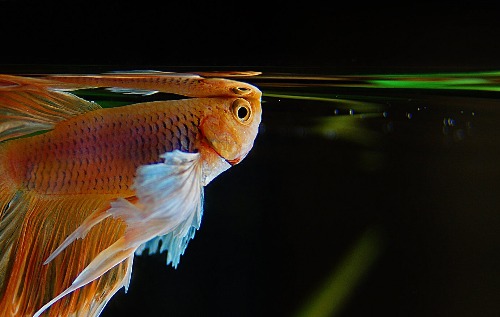
Photo credit: Dan the Hutt
Betta fish, the dazzling jewels of the aquarium world, are fascinating for reasons beyond their vibrant colors and flowing fins. Unlike most fish, bettas possess a remarkable ability: they can breathe air directly from the surface. This unique feature influences everything from their behavior to how we should care for them.
The Secret to How Betta Fish Breathe: The Labyrinth Organ
Click here for the best way to aerate your tank
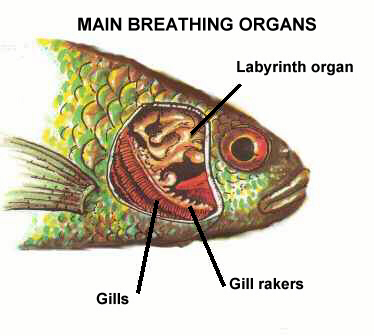
credit: Spread the betta love
The key to a betta’s air-breathing lies in the labyrinth organ, which is located above their gills. Imagine a miniature maze with thin, delicate tissues packed with blood vessels. When a betta breaks the surface, it gulps in the air, and these tissues extract oxygen like our lungs do! It’s an incredible adaptation that allows them to survive in environments other fish might find impossible.
An Evolutionary Advantage
Betta fish hail from Southeast Asia, inhabiting rice paddies, ditches, and shallow ponds. During dry seasons, these habitats can become hot, stagnant, and low in oxygen. The labyrinth organ gives bettas a lifeline, helping them thrive where other fish struggle. This same resilience is why bettas may tolerate less-than-ideal conditions in home aquariums, but it shouldn’t be an excuse for poor care.
Betta Bubble Nests: More Than Just Cute
Did you know those intricate floating bubble nests male bettas build have a vital purpose? These aren’t simply decorative – they’re cradles for their young! Male bettas blow saliva-coated air bubbles that form a sturdy raft at the surface. This ensures that the eggs and newly hatched fry always have access to air for breathing until they develop their labyrinth organs. It just goes to show how intertwined air-breathing is with the betta’s entire lifecycle.
Betta Care: Oxygen Myths and Must-Haves
Their air-gulping behavior sometimes leads to the misconception that bettas don’t need oxygen in their water. This is false! They still use their gills and require good water quality. Proper filtration for waste removal is essential. Avoid tall, narrow tanks with limited surface area for breathing. Wider, shallower tanks promote their natural behavior and health.
Catappa or Indian almond leaves for Betta Fish
The use of catappa leaves has a rich history. Indigenous communities in Southeast Asia have long valued them for their medicinal properties. Betta fish breeders and enthusiasts later recognized their potential. They discovered that catappa leaves or Indian almond leaves not only promote healing but also condition fish for competition and enhance their natural water conditions. They are a nature-sourced secret weapon for boosting your betta’s health, happiness, and longevity.
What are Indian Almond Leaves / Catappa Leaves?
These leaves come from the majestic Terminalia catappa tree, a tropical tree found in regions where betta fish naturally live. The leaves are large, with a leathery texture and a brownish hue when dried. In the aquarium world, they’re primarily sold in dried form and ready to use.
Why Are Indian Almond Leaves Beneficial?
Catappa leaves are packed with benefits for your betta fish. Here’s a breakdown:
- Health Powerhouse: These leaves are a natural medicine cabinet for your betta! They contain antibacterial and antifungal agents that fight harmful pathogens, helping prevent issues like fin rot, skin infections, and other ailments. Additionally, they strengthen immune function, making your betta less susceptible to disease. Learn more about betta diseases here.
- Stress Buster: Aquarium life can be different from a betta’s wild environment. Catappa leaves release tannins into the water, creating a slightly tinted, acidic environment that closely resembles their natural habitat. This significantly reduces stress, making your betta calmer, more vibrant, and likely to exhibit natural behaviors.
- Water Chemistry Master: Bettas prefer a slightly acidic and softer water environment. Conveniently, catappa leaves gently lower the pH and soften the water, creating conditions that contribute to your betta’s overall well-being.
- Cozy Hideaway: The leaves offer perfect hiding spots and places to rest. This sense of security is essential in reducing stress levels and allowing your betta to display its full personality.
How to Use Indian Almond Leaves
Click here for my favorite leaves for a betta tank
Using catappa leaves is simple:
- Preparation: Rinse the leaves thoroughly to remove dust and debris. Soak them in clean, dechlorinated water for a few hours or overnight. This softens them and reduces the initial release of tannins.
- Dosage: Start with one medium-sized leaf per 5-10 gallons of water. Observe your betta’s behavior and the water tint – you can adjust the dosage for a stronger or milder effect.
- Forms: Use whole leaves for a gradual tannin release, tear them into smaller pieces for a faster effect, or opt for convenient pre-made catappa leaf extracts.
- Replacement: As the leaves disintegrate, usually within a few weeks, replace them to maintain the benefits.
Alternatives
These alternatives can also be used, either in conjunction with or independently of catappa leaves:
- Alder Cones: Lower pH, release tannins and provide a different aesthetic.
- Banana Leaves: Offer antibacterial properties and hiding places when dried.
- Oak Leaves: Lower pH and offer shelter, though less commonly used in aquariums.
Where to Buy Indian Almond Leaves
Click here for my favorite leaves for a betta tank
Source your catappa leaves from reputable aquarium suppliers – online or in-store. Look for quality leaves free from pesticides.
FAQs
- Will catappa leaves stain my tank? They’ll add a slight brown tint, which is harmless and beneficial but may be an aesthetic consideration for some.
- How long do catappa leaves last? They’ll last several weeks before needing replacement.
- Can I use too many catappa leaves? Overdosing could drastically lower pH. Start with recommended amounts and monitor your water parameters.
Final Thoughts
Give your betta the gift of a more natural and fulfilling life with catappa leaves! See the difference in their health, vibrancy, and behavior. Your betta will thank you for it!





